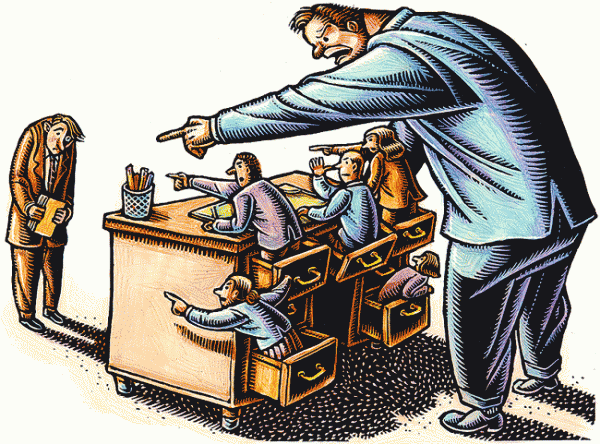What is Mobbing or Workplace Harassment?

The concept of mobbing (psychological harassment or bullying) has an ethical layer: a lack of respect and consideration of the employee’s right to dignity as an important or substantial element of the employment relationship (Piñuel and Cantero, 2002).
Individuals or groups of people who experience it suffer unjustified psychological violence due to negative and hostile acts, in or out of the workplace.
Mobbing can be inflicted by peers (“horizontal harassment”, among equals). It may also come from subordinates (in an upward vertical direction) or from superiors.
Is mobbing or workplace harassment common?
Data from the Cisneros barometer of the University of Alcalá indicate that more than 16% of the active workers surveyed say they have been subjected to psychological harassment or mobbing in their job in the last 6 months (Piñuel and Cantero, 2002). This means more than 2.3 million workers in Spain.
12% of the active workers surveyed agree fully that generalized harassment reduces efficiency in their workplace (Piñuel and Cantero, 2002).
“Never be mistreated in silence. Never allow yourself to be a victim. Do not let anybody else define your life, define yourself “.
-Tim Fields-
Forms of workplace harassment
Victims of workplace harassment end up believing they are a bad worker or a bad person. Mobbing doesn’t just attack one’s work performance. It can also impact one’s personal life as it can attack the image a person has of themselves.

An initially competent (even brilliant) colleague becomes a shadow of themselves. They think everything they do is wrong and that they are truly a disaster and they believe those who say that everything they do is wrong. This impacts their performance.
Accusations can eventually leading to psychological damage.
The usual objective of workplace harassment is for a person’s performance to deteriorate in order to make them resign or get fired.
How does mobbing or workplace harassment take place?
Methods of workplace harassment include:
- Yelling at or insulting the victim, or pushing them.
- Assigning them goals or projects with deadlines which are unattainable.
- Undervaluing or not valuing the effort the victim makes. Refusing to evaluate their work periodically.
- Threatening continuously or coercing.
- Ridiculing their work, their ideas or their results in front of their colleagues. Making fun and mocking.
- Changing duties and responsibilities without telling the victim.
- Treating them differently or discriminating against them. Stigmatizing them in the eyes of their colleagues or superiors. Excluding them.
- Ignoring, ostracizing or leaving them out, speaking only to a third person. Pretending they don’t exist.
- Withholding information crucial for their work or manipulating it in order to mislead them, and accusing them afterwards of negligence or professional misconduct.
- Defaming the victim. Spreading malicious or slanderous rumors throughout the organization that undermine their reputation or image.

“When people hurt you over and over again, think of them as sandpaper. They can scratch or hurt you a bit, but in the end, you end up polished and they end up being useless.”
-Chris Colfer-
Why does mobbing and workplace harassment occur?
Workplace harassment requires aggressors who work under the protection of organisational characteristics that allow them some impunity or scope for action. Except where the organisation exists for perverse ends, which is more typical of destructive organisations or sects, usually individuals engage in mobbing.
There are several reasons why aggressors engage in mobbing. The most common is that the worker who is the object of workplace harassment is or has become someone who is a threat to the group.
The most common factor in the studies of those who suffer psychological harassment in the workplace is jealousy due to an extraordinary professional ability or capacity.

The victim is often envied for the acceptance or appreciation that they arouse among their colleagues, subordinates, bosses, patients or clients. Also for their people skills, for positive evaluations or congratulations received for their work.
Other reasons
Workplace harassment can also happen when the worker refuses to be manipulated by others. Or because they are not “on the same page” as those who control the status quo.
In environments which contain various interest groups and leaders, mobbing usually consists of exterminating those unbeatable adversaries. Those who do not allow themselves to be compromised or bought and are seen as threatening.
Workers are also subject to harassment because they enjoy positive personal or family situations. Others who may lack them are jealous. When the victim is a woman, workplace harassment is triggered in some cases by them not being intimidated by sexual insinuations.
Another common reason for mobbing is difference. This is where some members of staff have particular characteristics that make them different from others. Being different in terms of age, qualification, language level, work experience, sex, customs… usually means persecution by the majority group (Piñuel and Cantero, 2002).
Abuse is when the least competent and most aggressive person projects their incompetence onto the most competent and least aggressive person.
Psychological consequences of workplace harassment
Several empirical studies confirm the association between workplace bullying and symptoms of Post-traumatic Stress Disorder (PTSD) (Mikkelsen and Einarsen, 2002). People who are victims of workplace harassment for a long period of time exhibit patterns of symptoms indicative of post-traumatic stress disorder, such as avoidance, repetition of the experience and increased emotional arousal.

Symptoms of avoidance lead to experiencing feelings of threat and/or fear of everything related to work. People who suffer mobbing avoid talking about work, they do not relate to people in the workplace and they make efforts to avoid activities or places or people related to the feared event.
Symptoms of re-experiencing appear in the form of nightmares or dreams related to events and work interactions. They also appear as recurring images and memories of the event or sensations that the event is happening again.
The symptoms of physiological activation displayed by workers suffering from mobbing during the workday are tachycardia, sweating, muscle tension, insomnia, hypervigilance, fits of anger, irritability and difficulty concentrating.
“The common mistake of bullies is to assume that because someone is kind or good, they are weak. These traits have nothing to do with each other. In fact, it takes considerable strength and character to be a good person “
-Mary Elizabeth Williams-
Workplace harassment is a troubling situation which we should be aware of to prevent it or stop it.
Bibliography
De Rivera, J. L. G. (2002). Psychological abuse: How to defend yourself against mobbing and other forms of harassment. Psiquiatria.com, 6 (3).
Hirigoyen, M. F., & Valls, N. P. (2001). Moral harassment at work: Distinguishing the true from the false.
Moreno Jiménez, B., Rodríguez Muñoz, A., Garrosa Hernández, E., & Morante Benadero, M. E. (2005). Organisational history of psychological harassment at work: an exploratory study. Psicothema, 17 (4).
Olivares, F. J. A. (2006). Mobbing: psychological harassment in the workplace. LexisNexis Argentina.
Peralta, M. C. (2004). Workplace bullying – mobbing – psychological perspective. Journal of social studies, (18), 111-122.
Peralta Gómez, M. C. (2006). Manifestations of workplace bullying, mobbing and symptoms associated with post-traumatic stress: case study. Psychology from the Caribbean, (17).
Piñuel, I., & Cantero, A. O. (2002). The incidence of ‘mobbing’ or psychological harassment at work in Spain. Results of the CISNEROS II® barometer on violence in the workplace. Lan Harremanak. Journal of Labour Relations, (7).
Piñuel, I. (2003). Mobbing. Self-help manual. Keys to recognising and overcoming psychological harassment at work. Madrid: Aguilar.
Rojo, J. V., & Cervera, A. M. (2005). Mobbing or workplace harassment. Tebar Publishers.
This text is provided for informational purposes only and does not replace consultation with a professional. If in doubt, consult your specialist.








